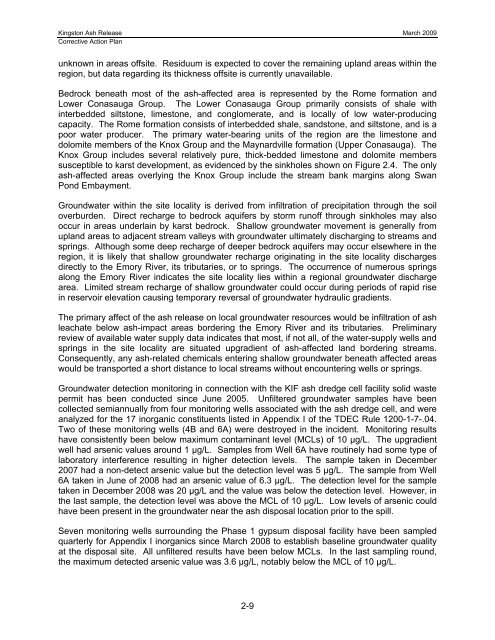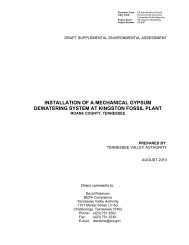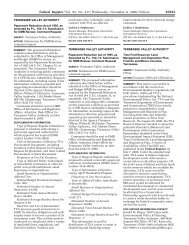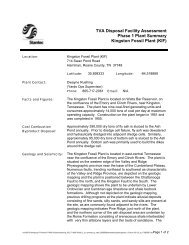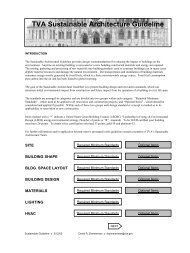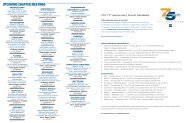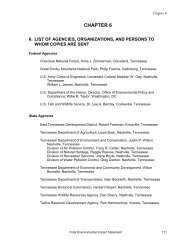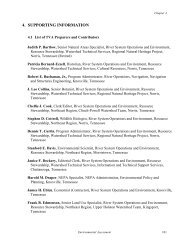Corrective Action Plan - Tennessee Valley Authority
Corrective Action Plan - Tennessee Valley Authority
Corrective Action Plan - Tennessee Valley Authority
Create successful ePaper yourself
Turn your PDF publications into a flip-book with our unique Google optimized e-Paper software.
Kingston Ash Release March 2009<br />
<strong>Corrective</strong> <strong>Action</strong> <strong>Plan</strong><br />
unknown in areas offsite. Residuum is expected to cover the remaining upland areas within the<br />
region, but data regarding its thickness offsite is currently unavailable.<br />
Bedrock beneath most of the ash-affected area is represented by the Rome formation and<br />
Lower Conasauga Group. The Lower Conasauga Group primarily consists of shale with<br />
interbedded siltstone, limestone, and conglomerate, and is locally of low water-producing<br />
capacity. The Rome formation consists of interbedded shale, sandstone, and siltstone, and is a<br />
poor water producer. The primary water-bearing units of the region are the limestone and<br />
dolomite members of the Knox Group and the Maynardville formation (Upper Conasauga). The<br />
Knox Group includes several relatively pure, thick-bedded limestone and dolomite members<br />
susceptible to karst development, as evidenced by the sinkholes shown on Figure 2.4. The only<br />
ash-affected areas overlying the Knox Group include the stream bank margins along Swan<br />
Pond Embayment.<br />
Groundwater within the site locality is derived from infiltration of precipitation through the soil<br />
overburden. Direct recharge to bedrock aquifers by storm runoff through sinkholes may also<br />
occur in areas underlain by karst bedrock. Shallow groundwater movement is generally from<br />
upland areas to adjacent stream valleys with groundwater ultimately discharging to streams and<br />
springs. Although some deep recharge of deeper bedrock aquifers may occur elsewhere in the<br />
region, it is likely that shallow groundwater recharge originating in the site locality discharges<br />
directly to the Emory River, its tributaries, or to springs. The occurrence of numerous springs<br />
along the Emory River indicates the site locality lies within a regional groundwater discharge<br />
area. Limited stream recharge of shallow groundwater could occur during periods of rapid rise<br />
in reservoir elevation causing temporary reversal of groundwater hydraulic gradients.<br />
The primary affect of the ash release on local groundwater resources would be infiltration of ash<br />
leachate below ash-impact areas bordering the Emory River and its tributaries. Preliminary<br />
review of available water supply data indicates that most, if not all, of the water-supply wells and<br />
springs in the site locality are situated upgradient of ash-affected land bordering streams.<br />
Consequently, any ash-related chemicals entering shallow groundwater beneath affected areas<br />
would be transported a short distance to local streams without encountering wells or springs.<br />
Groundwater detection monitoring in connection with the KIF ash dredge cell facility solid waste<br />
permit has been conducted since June 2005. Unfiltered groundwater samples have been<br />
collected semiannually from four monitoring wells associated with the ash dredge cell, and were<br />
analyzed for the 17 inorganic constituents listed in Appendix I of the TDEC Rule 1200-1-7-.04.<br />
Two of these monitoring wells (4B and 6A) were destroyed in the incident. Monitoring results<br />
have consistently been below maximum contaminant level (MCLs) of 10 µg/L. The upgradient<br />
well had arsenic values around 1 µg/L. Samples from Well 6A have routinely had some type of<br />
laboratory interference resulting in higher detection levels. The sample taken in December<br />
2007 had a non-detect arsenic value but the detection level was 5 µg/L. The sample from Well<br />
6A taken in June of 2008 had an arsenic value of 6.3 µg/L. The detection level for the sample<br />
taken in December 2008 was 20 µg/L and the value was below the detection level. However, in<br />
the last sample, the detection level was above the MCL of 10 µg/L. Low levels of arsenic could<br />
have been present in the groundwater near the ash disposal location prior to the spill.<br />
Seven monitoring wells surrounding the Phase 1 gypsum disposal facility have been sampled<br />
quarterly for Appendix I inorganics since March 2008 to establish baseline groundwater quality<br />
at the disposal site. All unfiltered results have been below MCLs. In the last sampling round,<br />
the maximum detected arsenic value was 3.6 µg/L, notably below the MCL of 10 µg/L.<br />
2-9


